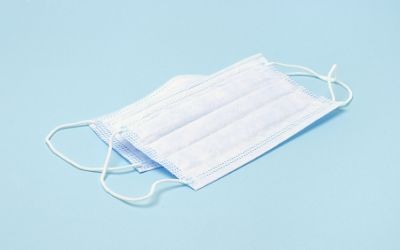Simple Face Masks Could Significantly Prevent Spread of TB to Non-Infected Patients

Face masks worn by patients infected with tuberculosis (TB) may be able to significantly cut transmission rates to non-infected patients, according to a new study by researchers from the U.S. and South Africa. The study was conducted in a specialized airborne infections research facility in South Africa, which was designed to allow study of methods to control the spread of TB. Transmission rates were measured using healthy guinea pigs exposed to infected patients. The results of the study will be presented at the ATS 2011 International Conference in Denver.
We found that when infectious patients with multidrug resistant tuberculosis (MDR-TB) wore face masks while they were hospitalized, the face masks helped decrease the transmission of tuberculosis by 50 percent compared to when the patients did not wear face masks, says study author Ashwin Dharmadhikari, MD, associate physician at Harvard Medical Schools Brigham &Womens Hospital. Simply put, face masks were able to cut tuberculosis transmission in half.
The masks may represent a simple way to reduce TB transmissions in areas with limited resources and widespread TB. This is especially important when one thinks about the importance of protecting healthcare workers and other patients from getting TB when these vulnerable individuals might be in the same room as a TB patient, says Dharmadhikari.
During the three-month study period, a series of 17 adult TB patients occupied the Airborne Infections Research Facility ward at the Mpumalanga Provincial MDR-TB Referral Hospital in Emalahleni, South Africa. Each patient occupied the ward for three weeks before being replaced and was encouraged and monitored to make sure face masks were worn for 12-hour periods on alternate days. Masks were removed during mealtimes and to allow patients to take medications.
A mechanical ventilation system exhausted all ward air on alternating days to each of two identical exposure chambers holding 180 healthy guinea pigs equally divided into an intervention group and a control group. Skin tests to monitor for tuberculosis infection were administered to the guinea pigs at the beginning of the study and monthly during the study. Intervention group animals only breathed ward air during periods when patients wore surgical face masks, and control animals only breathed ward air during periods when patients did not wear any masks. At the end of the study, efficacy was determined by comparing the incidence of infection among animals in each chamber.
Guinea pigs in the control group had more than twice the risk of becoming infected compared to guinea pigs in the intervention group. In the control group, 69 animals (76 percent) became infected. In the intervention group, 36 animals (40 percent) became infected.
These findings provide evidence on methods that could be used for TB control, Dharmadhikari says. They may also help healthcare facilities and other stakeholders involved in TB control decide on how suitable this intervention is for protecting individuals against TB infection in the environments in which they work.
In a traditional clinical setting, the efficacy of face mask use will depend in part on the ability of the patient to keep the mask on, Dharmadhikari notes.
In the current study, patients wore the masks for 12-hour periods on alternate days, which may be difficult to achieve in actual inpatient clinical settings, he said. However, mask usage for shorter periods of time, such as when patients with chronic cough or other symptoms suggestive of TB present to a clinic or hospital for evaluation, may be more easily achievable and still provide reduction in transmission, he adds.
In those settings, it may be possible to encourage patients to wear masks while they are getting worked up for TB, so that the chances of healthcare workers or other patients getting TB are reduced, he says.
Dharmadhikari says additional studies are needed to determine how well face mask use is accepted by patients, healthcare workers and health systems, how masks contribute to a hospitals infection control program, and whether masks are economically and logistically feasible interventions in settings with a high burden of TB.
It is important to keep in mind that masks should be viewed as part of a comprehensive TB infection control program that also includes timely diagnosis of TB patients and initiation of effective treatment, he notes. While masks worn by patients helped reduce TB transmission, they likely best fit into a plan that includes additional methods of TB infection control.
Â
Unraveling a Candida auris Outbreak: Infection Control Challenges in a Burn ICU
March 19th 2025A Candida auris outbreak in a burn intensive care unit (BICU) in Illinois has highlighted the persistent challenges of infection control in high-risk health care settings. Despite rigorous containment efforts, this multidrug-resistant fungal pathogen continued to spread, underscoring the need for enhanced prevention strategies, environmental monitoring, and genomic surveillance.
Unmasking Long COVID: Dr Noah Greenspan on Recovery, Research Gaps, and the Future of Treatment
March 18th 2025Dr Noah Greenspan discusses the evolving understanding of long COVID, current treatment strategies, diagnostic challenges, and the critical need for research and awareness in post-viral syndromes.
From Shortages to Security: How Reusable Health Care Textiles Can Transform Infection Prevention
March 7th 2025Reusable health care textiles enhance infection prevention, reduce waste, and strengthen supply chains. Hygienically clean textiles offer a sustainable, cost-effective alternative to disposable PPE, ensuring patient safety and environmental responsibility.